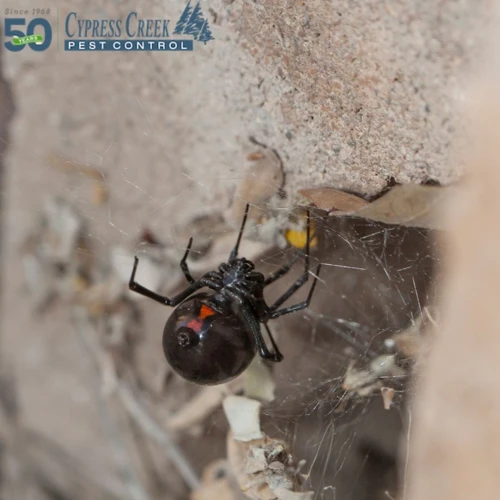As homeowners, we often take great lengths to ensure our homes are safe and secure. However, one of the greatest threats to our safety may be hidden in plain sight. Black widow spiders are a common issue in many areas, and their bites can be deadly to both humans and pets. What many people don’t realize is that these pests often gain entry to our homes by utilizing cracks and openings in the walls. In this article, we will explore why sealing these openings is crucial in preventing black widow spider infestations, and provide a step-by-step guide to help you protect your home.
The Danger of Black Widow Spiders
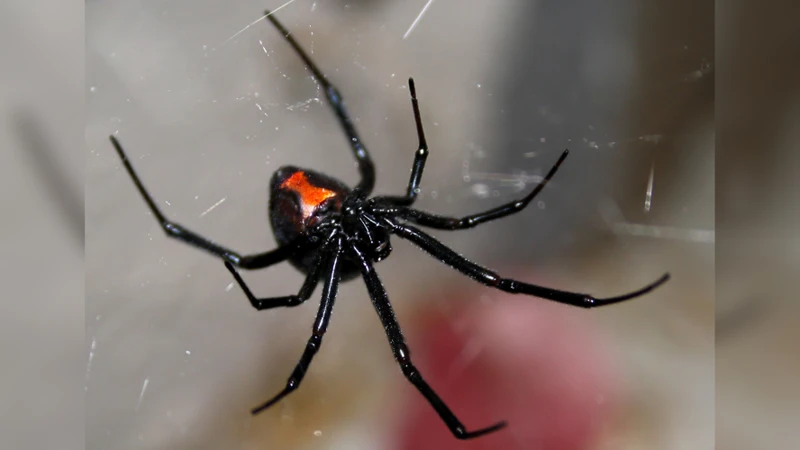
It’s vital to understand the danger of black widow spiders in order to take adequate measures for prevention. One of the most feared spiders in the world, black widows are notorious for their venomous bites. These spiders are more commonly found in warmer areas such as California, Arizona, and Florida; however, there have been sightings across the United States. In this section, we will explore the risks associated with these spiders and how to identify them. By knowing the dangers, you can take the necessary steps to protect you and your family from these potentially deadly creatures.
Identification
Black widow spiders are easily identified with their distinctive shiny black body, rounded abdomen and bright red hourglass-shaped mark on the underside. Females are larger than males and can reach up to 1.5 inches in length. It’s important to note that not all black spiders are black widows, so it’s essential to confirm their identity before taking any preventive measures.
One way to differentiate between a black widow spider and other black spiders is by observing their web. Black widows typically create a tangled, disorganized web that is not symmetrical in shape as compared to other spider webs which tend to be symmetrical and better organized. They prefer to make their webs in undisturbed, quiet areas such as garages, attics, and basements. It’s also important to remember that black widow spiders are typically shy and will only bite when threatened or disturbed.
If you suspect that you have a black widow spider infestation, it’s important to take action immediately to avoid any potential danger. Sealing the cracks and gaps in and around your home is the first step to black widow prevention, as it’s through these openings that the spiders make their way into your home. Some common signs of a black widow infestation are spider sightings or the presence of discarded webs in dark, quiet crevices in your home.
To effectively prevent black widow spider infestations, it’s essential to carry out a thorough examination of your home. Make sure to check attics, basements, garages, outdoor sheds, crawl spaces, and any other areas where spiders may hide in. The most common entry points for black widows are vents, pipes, windows, and doors, especially if they are near lighting fixtures or porch lights. You can also check siding, window frames, and electrical outlets for any gaps and cracks that may allow spiders to enter your home.
The best way to keep black widow spiders out of your home is to seal these entry points using caulking, weatherstripping, or other appropriate materials. The process of sealing the cracks and gaps in and around your home is relatively simple and straightforward, requiring just a few basic tools and materials. You can find step-by-step guides and tutorials online on how to seal these entry points. Just make sure to use the appropriate materials and products, depending on the location and size of the crack or gap.
By taking the time to identify and seal entry points in and around your home, you can effectively prevent black widow spiders from infesting your living spaces. With these simple preventive measures, you can create a safe and secure environment for you and your family. For more tips on sealing entry points and preventing black widow spider infestations, check out this guide on how to seal cracks to avoid black widows.
Bites and Symptoms
Black widow spider bites are known for being one of the most venomous bites in the United States. **The bites are usually not felt initially but after one to three hours, a sharp pain may develop**. In some cases, the pain can expand to other parts of the body. Symptoms of black widow spider bites can be severe, especially in young children and people with compromised immune systems. These symptoms include:
- Muscle cramps, spasms, and stiffness in the abdomen, back, and extremities – These symptoms usually peak within six to eight hours after the bite and can last for several days.
- Fever and chills
- Sweating
- Headache and body aches
- Nausea and vomiting
If you’re experiencing any of these symptoms, it’s important to seek medical attention immediately. **In rare cases, black widow spider bites can be fatal**. So it’s important to take all the necessary precautions to prevent infestations in your home.
Sealing cracks and openings can be an effective strategy to keep black widow spiders out of your home. **Check out our step-by-step guide below for information on how to seal your home and prevent black widow spiders from entering**.
The Role of Cracks and Openings in Infestations
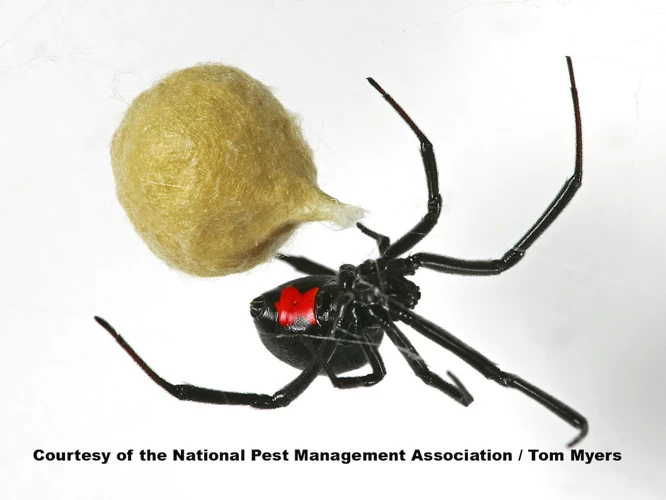
Cracks and openings in your home can serve as the perfect entry point for black widow spiders and other pests. Black widow spiders are attracted to warm, dry environments where they can build nests and feed on insects. They often enter homes in search of shelter and food.
Sealing cracks and openings is an effective way to prevent black widow spiders from entering your home. By sealing gaps and holes, you can block the spiders’ entry points and reduce the risk of an infestation. Even the smallest of cracks can allow black widow spiders to enter, so it is essential to be thorough in your sealing efforts.
But why exactly are cracks and openings so important in spider prevention? Well, when spiders are in search of a new environment to inhabit, they seek out spaces that can provide them with a suitable habitat. In particular, they are drawn to areas that can provide them with shelter and prey.
Cracks and openings in walls, doors, windows, attics, and basements make excellent habitats because they provide access to the spiders’ food source. Once they have entered through an opening, they can easily set up a nest and begin preying on other insects in the area. This can result in an infestation that can be challenging to control.
To prevent black widow spider infestations, it is essential to block off any potential entry points. This means sealing all cracks and openings with suitable materials such as caulk, weatherstripping, and foam insulation. You can find various materials and tools for sealing gaps and openings at your local hardware or home improvement store.
If you’re unsure where to begin, a step-by-step guide can be helpful in sealing cracks and openings around your home. A step-by-step guide can provide detailed instructions on how to use materials such as caulk and weatherstripping to seal cracks around doors, windows, and other openings in your home. You can find many step-by-step guides online or at your local home improvement store.
Common entry points that require sealing are pipes, electrical outlets, windows, doors, and gaps in siding and foundations. By sealing these areas, you can reduce the risk of a black widow spider infestation. You can also use air sealing methods to keep spiders out of your home.
In addition to sealing cracks and openings, there are other prevention strategies you can implement to keep black widow spiders at bay. For example, keeping a clean and clutter-free home can help reduce the risk of spider infestations. Using pesticides and sprays can also be helpful in preventing spiders from entering your home.
However, if you have already noticed signs of a black widow spider infestation, it’s essential to call a professional pest control service immediately. Pest control professionals can help you identify the severity of the infestation and take the necessary steps to remove the spiders from your home safely.
Sealing cracks and openings is a crucial step in preventing black widow spiders from entering your home. By being thorough in your sealing efforts and implementing other prevention strategies, you can reduce the risk of an infestation and keep your family safe from these potentially dangerous spiders. Use this link to learn more about sealing cracks and preventing black widow infestations.
How to Seal Cracks and Openings
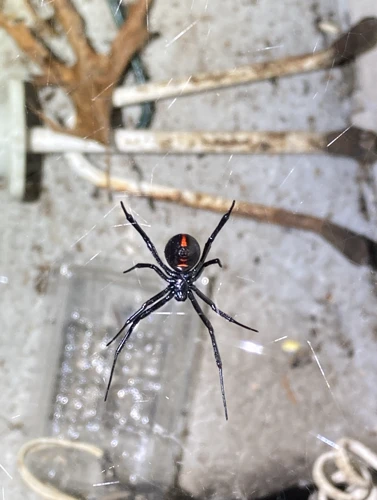
Taking action to seal cracks and openings in your home is an essential step in preventing black widow spiders from entering your living space. These spiders can enter your home through the smallest of openings, so it’s important to take a detailed approach to sealing them off. By following the step-by-step guide below, you can prevent these dangerous spiders from entering your home and posing a threat to your health and safety. Additionally, we’ll explore some common entry points to seal and other prevention strategies that can help keep your home free from black widow spiders.
Step-by-Step Guide
Step-by-Step Guide for Sealing Cracks and Openings:
Here is a step-by-step guide for sealing cracks and openings in your home to prevent black widow spider infestation:
| Step 1 | Inspect your home for potential entry points where black widow spiders may gain entry. Common entry points may include cracks in the foundation, gaps around windows and doors, and holes around pipes. |
| Step 2 | Seal any cracks or gaps in your home’s foundation using caulking or foam sealant. For larger gaps, consider using wire mesh to cover the opening before sealing it with caulking. |
| Step 3 | Use weather stripping or door sweeps to seal gaps and openings around doors and windows. |
| Step 4 | Seal any gaps or holes around pipes using expandable foam or caulking. This will also help reduce energy costs by keeping your home better insulated. |
| Step 5 | Consider installing screens on windows, doors, and vents to prevent spiders from entering your home. |
| Step 6 | For electrical outlets, switch plates, and light fixtures, use foam gaskets or outlet covers to seal any gaps around these fixtures. (source) |
Remember, it’s important to be thorough when sealing your home to prevent black widow spider infestations. By taking these steps, you can protect your loved ones and give yourself peace of mind. You can also check other methods for sealing cracks and gaps (source), (source), (source), (source), (source), (source) to get more insights.
Common Entry Points to Seal
It’s no secret that properly sealing cracks and openings in your home can make a big difference in preventing black widow spiders from entering. Here are some of the most common entry points to look out for:
- Doors and Windows: As obvious as it may sound, doors and windows are often the most commonly overlooked areas when it comes to sealing up a home. Be sure to inspect each and every door and window in your home, particularly the seals and frames, and ensure there are no gaps or cracks.
- Pipes and Wires: Pipes and wires entering your home can create small holes on your walls, making them a potential entry point for black widows. Use sealant or caulk to fill in any gaps around the pipes and wires that might be creating openings for spiders to enter.
- Vents and Exhausts: Dryer vents, bathroom exhausts, and other vents opening to the outside of your home are another common entry point for spiders. Seal any gaps and replace damaged screens to keep spiders out.
- Foundation and Siding: Check the foundation and siding around your home for any cracks or gaps where spiders might be able to crawl in. Use expandable foam or sealant to fill any noticeable gaps or cracks.
- Garage and Attic: These areas are often neglected due to the amount of clutter that tends to accumulate over time. Take some time to clear out any debris and search for any openings where black widows could be entering. Be sure to use sealant or caulk to cover up any holes found.
By taking the time to seal these common entry points, you can significantly reduce the likelihood of black widow spiders entering your home. Remember, prevention is key when it comes to keeping your home spider-free!
Other Prevention Strategies
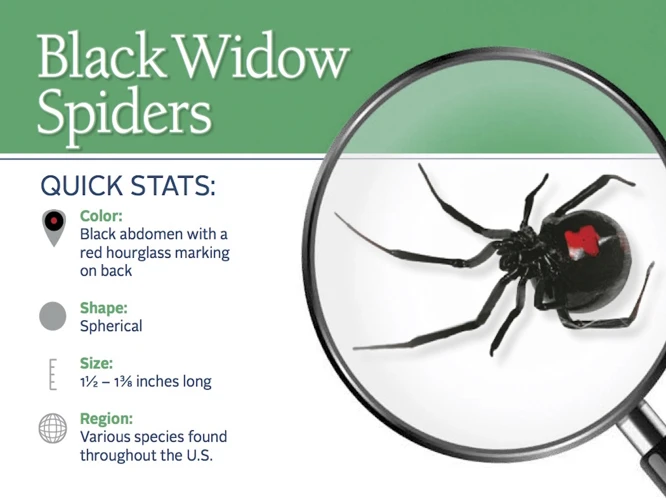
While sealing off cracks and openings in your home is a crucial step in preventing black widow spider infestations, it shouldn’t be the only one. There are other prevention strategies that you should consider. These strategies not only complement the sealing process but also help ensure that you minimize the risk of coming across these venomous spiders. In this section, we’ll explore some of these strategies in detail and show you how to combine them with sealing for optimal black widow spider prevention.
Keeping a Clean Home
Maintaining a clean home is one of the most effective prevention methods when it comes to black widow spiders. Black widow spiders thrive in cluttered and dusty environments, making it crucial to keep the living spaces clean and free of debris. Here are some tips on how to keep a clean home to prevent black widow infestations.
| Tip | Description |
|---|---|
| Regular cleaning | Make sure to schedule a regular cleaning routine to prevent dirt, dust, cobwebs, and other debris from accumulating in your house. |
| Vacuuming | Use a vacuum cleaner to get rid of spider webs and debris from floors, corners, windowsills, ceilings, and other areas where spiders often build nests. |
| Dusting | Dust all surfaces, including shelves, furniture, and other items regularly to prevent spider webs and other debris from accumulating. |
| Organizing clutter | Keep clutter and unnecessary items to a minimum, storing them in closets, cabinets, or storage boxes. This reduces hiding spots and webs created by spiders. |
| Outdoor cleaning | Clean the yard area adjacent to your home, removing any debris, junk, or unused items, as these locations also attract spiders. |
| Proper waste disposal | Dispose of your trash regularly and properly. Leaving garbage outside or storing it in cans without tight-fitting lids can be a breeding ground for insects and spiders. |
By keeping your house clean and clutter-free, you are not only creating an inhospitable environment for black widow spiders, but also promoting a healthy living space for you and your family. Remember to schedule a regular cleaning routine and modify your habits to prevent unnecessary debris accumulation.
Using Pesticides
One way to prevent black widow spiders from infesting your home is by using pesticides. This can easily be done by following these steps:
- Identify the areas where spiders are most likely to hide. Black widows are usually found in dark corners, under furniture and appliances, and in cluttered areas. Check these areas and mark spots that need treatment.
- Choose the right pesticide. Look for a pesticide that’s specifically designed for black widow spiders. Read the label carefully, follow instructions, and wear protective clothing, such as gloves and a mask.
- Apply the pesticide. Spray the pesticide on the marked areas, paying close attention to cracks and openings. Leave the area immediately after application, and keep it closed for several hours. Make sure to ventilate the room before re-entering.
While using pesticides can be an effective way to prevent black widow spiders from entering your home, it’s important to note that they can be dangerous to humans and pets. Always follow the instructions carefully, and consider using natural remedies if you’re concerned about the chemicals. Additionally, pesticides can be harmful to the environment, so it’s important to use them sparingly and responsibly.
Using pesticides can be a helpful method of preventing black widow spiders from infesting your home, but it’s important to weigh the potential risks and take precautions when using these chemicals.
When to Call a Professional
While sealing cracks and openings is an effective prevention strategy against black widow spiders, sometimes it may not be enough. It is important to know when to call a professional for help. Here are some situations where you should consider professional help:
Large Infestations: If you have noticed a large number of black widow spiders in and around your home, it is a sign that their population has grown beyond your control. In such a case, it is best to call pest control professionals who have the necessary tools and expertise to eliminate the infestation.
Repeated Infestations: If you have had to deal with black widow spider infestations frequently, it is an indication that your prevention techniques aren’t effective enough. A professional can help identify the root cause of the problem and implement a comprehensive solution.
Complicated Structures: If your home has a complicated structure with hard-to-reach areas, it can be challenging to find and seal all the possible entry points. In this case, a professional can use specialized equipment and techniques to identify and seal entry points that are otherwise difficult to access.
Venomous Spiders: While black widow spiders are one of the most dangerous spiders, they aren’t the only venomous spider species out there. If you are dealing with venomous spiders other than black widows, it is best to seek professional help as they pose a serious risk to your health and safety.
In some cases, the use of pesticides might be necessary to deal with black widow spiders. However, it is essential to use them responsibly and with caution. A professional pest control service can ensure that pesticides are used safely and effectively to prevent harm to you, your family, and pets.
If you are dealing with a severe or repeated black widow spider infestation, have a complicated home structure, or are dealing with venomous spiders other than black widows, seeking professional help is the best course of action.
Conclusion
In conclusion, taking the necessary steps to seal cracks and openings in your home is crucial in preventing black widow spider infestations. These venomous creatures can pose serious hazards to your health and that of your family, so it’s important to take their presence seriously.
By following the step-by-step guide and sealing off common entry points, you can significantly reduce the risk of having black widow spiders invade your living spaces. Additionally, keeping a clean and clutter-free home and using pesticides can further help prevent infestations from occurring.
However, if you suspect that a black widow spider has already made its home in your property or if you’re unsure about how to effectively seal off certain areas, it’s best to seek the help of a professional pest control service. They have the expertise and tools necessary to not only identify and remove any existing spider infestations, but also to provide comprehensive prevention strategies.
Don’t wait until it’s too late to address potentially dangerous spider infestations in your home. Take the necessary measures to seal off cracks and openings, and enjoy a safer, healthier living environment for you and your loved ones. Remember, prevention is always better than cure.
Frequently Asked Questions
What does a black widow spider look like?
A black widow spider is typically shiny and black, with a distinctive hourglass shape on its abdomen. Female black widows are larger than males and may have additional red or white markings on their bodies.
Do black widow spider bites always cause symptoms?
No, not everyone bitten by a black widow spider will experience symptoms. However, it’s important to seek medical attention immediately if you think you may have been bitten.
Can sealing cracks and openings really prevent black widow spider infestations?
Yes, sealing cracks and openings in your home can greatly reduce the chances of black widow spiders entering and establishing an infestation.
What are some common entry points for black widow spiders?
Common entry points for black widow spiders include gaps around doors and windows, holes in screens, gaps under doors, and cracks or gaps in the foundation.
What should I use to seal cracks and openings?
For best results, use a silicone-based caulk to seal any cracks or openings around your home. This type of caulk is flexible and durable, making it an effective barrier against spiders and other pests.
Do I need to hire a professional to seal cracks and openings?
No, sealing cracks and openings is a simple task that can be done by most homeowners. However, if you’re not comfortable working with caulk or have a serious infestation, it’s best to call a pest control professional.
Should I use pesticides to prevent black widow spiders?
While pesticides can be effective in eliminating black widow spiders, they should only be used as a last resort. Always follow the manufacturer’s directions carefully and use caution when applying pesticides in your home.
What other pests can be prevented by sealing cracks and openings?
Sealing cracks and openings can help prevent a wide range of pests from entering your home, including ants, cockroaches, and rodents.
Will keeping my home clean really help prevent black widow spiders?
Yes, keeping your home clean can be an effective way to prevent black widow spiders. Eliminate clutter, vacuum regularly, and keep food stored in airtight containers to deter spiders and other pests.
What should I do if I find a black widow spider in my home?
If you find a black widow spider in your home, it’s best to call a pest control professional to safely remove it. Do not attempt to handle or kill the spider yourself.

